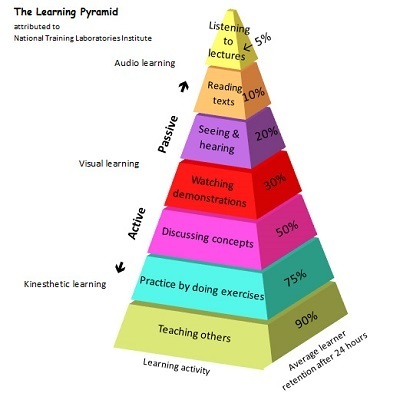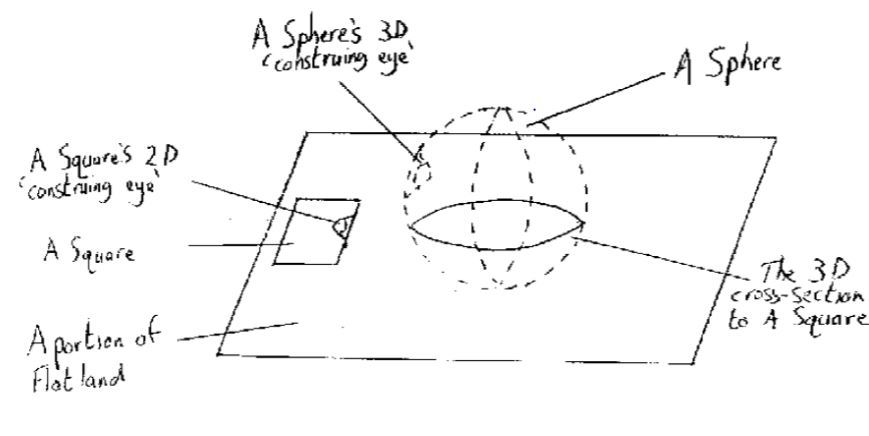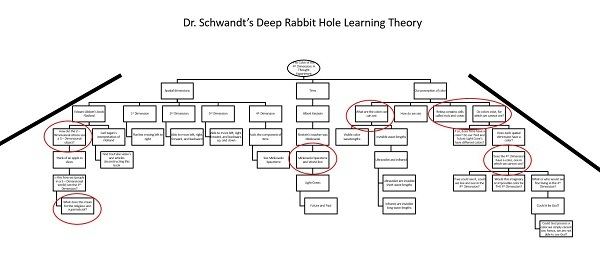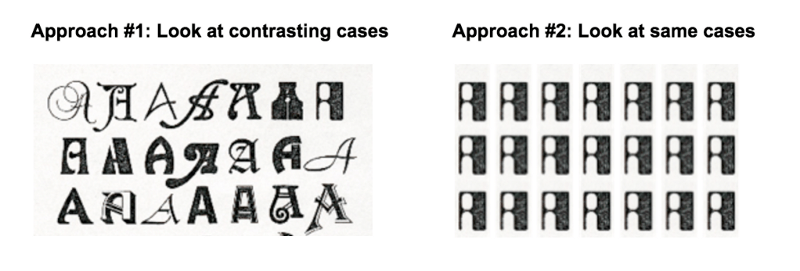Do you have difficulty comprehending a new concept after you read? Do you refuse to even attempt to improve your math skills? If this sounds like you, stop worrying because there is a simple approach you can use to improve. The trick is to simply apply what you are learning.
Without any additional application, we will only retain 10% of what we read. 10%! Yet, if we attempt to teach others a new concept, we find that we are able to retain 90% of the information. Even simply discussing the concept with others will help us retain 50% of the information. Essentially, reading or learning a new concept will provide us no practical good without practice.[1]
So, let’s look at what it actually means to apply what we learn and how we can use some powerful techniques to improve.
Learning = Download + Process + Apply
Think of the application of knowledge through this analogy: You have two islands separated by a river. One island represents knowing, the other island represents understanding. The application of new knowledge is like building a bridge between the two; hence, applying new knowledge bridges the gap between knowing and understanding.
We should strive to create a habit of always considering ways to immediately implement what we are reading or learning into our daily lives. Let me show you why this is important by looking at a formula for learning called The Learning Formula (TLR).
With TLR, we start by learning something new, followed by actively processing new knowledge, then applying it as soon as possible; thus, demonstrating that learning updates in our brain by using the following formula: Learning = Download + Process + Apply.
Let’s briefly breakdown each component of the TLR.
Download
Similar to how a computer downloads information, we must first download knowledge. We can do this through the following ways: reading a book, listening to an audiobook, watching a video online, or listening to a lecture.
The first thing we should do after downloading new information is to deconstruct it. Elon Musk has mastered this concept and found that knowledge has a logical structure. Drake Baer writes, “Over 2,300 years ago, Aristotle said that a first principle is the first basis from which a thing is known and that pursuing first principles is the key to doing any sort of systemic inquiry.”[2]
Process
We process new knowledge when we connect the dots between new and old ideas. Essentially, we are connecting new chunks of information with something we already know. Here are two great ideas to use when processing new information.
- Analogies. An analogy is simply a comparison between two concepts for the purpose of explanation. Here is a brilliant (and a favorite of mine) example of an analogy (could also be a metaphor) for Alice’s Adventures in Wonderland by Lewis Carol.
When Carol’s expedition into whimsical absurdity opens, a young girl (Alice) is strolling through a meadow, when a rabbit suddenly appears. She thinks nothing of it at first, until the rabbit pulls out a watch and looks at it. She realizes this is not an ordinary rabbit. This represents the new and unexplored or a burning curiosity. Alice runs after the rabbit like chasing a new idea. She decides to follow the rabbit down a rabbit hole, never considering how she would get out. This represents following through with a new idea for the excitement of discovery is like chasing the rabbit or idea down the rabbit hole. Alice is unsure where this chasing will take her, yet she is excited to pursue the idea without question. [3]
- Diagrams. A diagram is a drawing that represents the appearance or structure of something in graphic form. This could be anything from a simple sketch to a detailed outline of the universe. For example, let’s look at a diagram to help us understand how objects interact in the classic book Flatland.
Apply
Let me ask you a simple question. What good does it do you to read or learn new information if you are not going to use it? Unless you are reading something for pure enjoyment (think Harry Potter), you must have the mindset of using the new knowledge to improve yourself.
By applying what we learn, we are able to secure it in long-term memory. One of the best ways to apply our knowledge is to teach it. Teaching forces us to dive into the concept and really start to understand it. However, the best way is to start applying it in your line of work and immediately use it. Once you gain practical experience with this new concept, try to explain the technical information to someone. For example, write a blog about it. It’s amazing what this can do for you retention of new knowledge!
Let’s take a look at some of the benefits of applying new knowledge.
- Improved Problem Solving. By applying what we learn, we become better problem solvers. The more we read and learn, the more information and knowledge we come across. If we apply it in our daily life, we will start to notice we use this new knowledge daily.
- Improved Memory. The more we apply new knowledge, the better it will stick in our memory.
Let your mind go wild and go down the rabbit hole
If you find that you are the type of person who consistently goes down rabbit holes when learning or discussing a new concept… embrace it! Yes, embrace it! Here is why.
I recently created a new theory for learning. I call it the Deep Rabbit Hole (DRH) Learning Theory. I constructed the theory on the following premises.
• Premise #1. Learning a new concept takes us down a rabbit hole.
• Premise #2. Inside the rabbit hole, we find new ideas are easily connected to old ideas.
• Conclusion. Therefore, learning a new concept is easier by allowing yourself to go down a rabbit hole.
The key to this approach is to allow yourself the freedom to freely fall down the rabbit hole. When you chase the rabbit down the hole without any hesitation, you will be amazed where you end up! Here is how I construct my DRH (with a brief example).
• Restate the question.
• Clearly define the purpose.
• Use a DRH. Similar to a semantic tree: deconstruct the concept, question, or idea.
• Clearly identify the parts of the rabbit hole you want to apply. Here, you are coloring or circling those components you would like to further apply or break down into their own DRH. This is important, because a DRH will lead to lots of new ideas to get lost in!
This is going to sound completely crazy, but I used a DRH to conduct a thought experiment. This approach allowed me to create a new (and crazy) theory. The Color of the 4th Dimension. The image below is an example of this creation.
Elon Musk’s brilliant approach
In my opinion, there is no one doing more to move the world forward today than Elon Musk. Musk is an advocate for learning across multiple fields. If we embrace learning across multiple fields, we find that we possess an information advantage as most people are solely focused on just one field.[4]
Learning Transfer
Musk has a large thirst for knowledge. He regularly exposes himself to numerous subjects. He also practices a skill known as the Learning Transfer. Essentially, this is taking what we learn and applying it to something else. Think of learning something in physics class and using it in sociology. For this, Musk has a two-step process.
- Contrasting Cases. This is where you deconstruct something and look for the deeper understanding of it. For example, suppose you wanted to find the deeper principle for what makes the letter A an A. See below.
- Reconstruct the principles you learn into different fields. To effectively do this, we should ask ourselves the following questions: “What does this remind me of?” and “Why does it remind me of it?”
Other powerful techniques
Lastly, there are quite a few additional techniques and examples we can use; however, I have narrowed the list down to two powerful techniques.
- ADEPT. When trying to comprehend a difficult concept, try the following: Find an Analogy, use a Diagram, Experience it, explain it in Plain English, and describe the Technical Details. [5]
- Solo Taxonomy. Structure of Observed Learning Outcome. This is a model describing the levels of increased complexity. Here, you move from an abstract thought, to a clear image, then to a creative and better outcome.
I encourage you all to embrace the application of new knowledge. To me, this is common sense. Unless we use it, we will lose it. Learning plus thinking equals creating! Lastly, remember this powerful advice from Marianne Williamson:
“You must learn a new way to think before you can master a new way to be.”
Reference
| [1] | ^ | The Stock Bandit: Apply what you learn or stop learning |
| [2] | ^ | Business Insider: Elon Musk just gave an amazing tip on how to learn a lot quickly |
| [3] | ^ | C.S.I. Wonderland: Down the rabbit-hole – what does it mean? |
| [4] | ^ | Quartz: How Elon Musk learns faster and better than everyone else |
| [5] | ^ | Lifehack: Learning can be much easier if you follow this 5-step approach |
















































